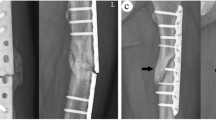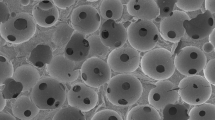Abstract
In this experimental study with bone defects, we focussed on the one hand on external and internal osteogenic callus formation after filling the defect and on the other on the osteochondrogenic differentiation capacity of 4-day-old fibrous-like callus grafts and 12-day-old woven bone grafts in an osteogenic environment. A standard cortical bone defect of the femur was created in 95 young rats. The defect was filled with a cortical bone graft and 4- and 12-day-old callus grafts. The grafts were transplanted as such or in Nucleopore chambers. Follow-up was done at 1, 2, 3 and 6 weeks. The osteochondrogenic tissue formed was studied histologically and histomorphometrically. The results suggest that the filling of the bone defect had no influence on the primary external and internal osteogenic callus formation at 1 and 2 weeks. At 3 and 6 weeks in the chamber groups the persisting internal bridging woven bone was converted into more compact lamellar bone whereas periosteal callus remained at the edges of the defect. In the other groups at 3 and 6 weeks the normal shape of the cortex was reconstituting. Four-day-old fibrous-like callus formed bone in the Nucleopore chamber, indicating that fibrous-like callus tissue at 4 days contains osteogenic cells. Twelve-day-old callus consisting of woven bone was partially differentiated to cartilage, showing that woven bone contains cells capable of chondrogenic differentiation.
Similar content being viewed by others
References
Beresford JN (1989) Osteogenic stem cells and the stromal system of bone and marrow. Clin Orthop 240:270–280
Brighton CT, Krebs AG (1972) Oxygen tension of healing. J Bone Joint Surg [Am] 54:323–332
Chao EYS, Aro HT, Lewallen DG, Kelly PJ (1989) The effect of rigidity on fracture healing in external fixation. Clin Orthop 241:24–35
Draenert Y, Draenert K (1980) Gap healing of compact bone. 4th SEM Inc., AMF O'Hare, Chicago, 103–111
European Convention for the Protection of Vertebrate Animals Used for Experimental and Other Scientific Purposes (1987) European Treaty Series No. 123. Council of Europe, Strasbourg
Goldner J (1938) A modification of the Masson trichrome technique for routine laboratory purposes. Am J Pathol 14:237–243
Göransson H (1993) Callus formation after re-injury to the experimental bone defect. Arch Orthop Trauma Surg 112:232–235
Göransson H, Pätiälä H, Linden M, Vuola J, Rokkanen P (1992) Histology and histomorphometry of bone regeneration after experimental injuries. Ann Chir Gynaecol 81:58–65
Grobstein C (1953) Morphogenetic interaction between embryonic mouse tissues separated by a membrane filter. Nature 172:869–871
Hansen-Leth C (1979) Bone vascularization and bone healing in the amputation stump. Acta Orthop Scand 50:39–47
McKibbin B (1978) The biology of fracture healing in long bones. J Bone Joint Surg [Br] 60:150–162
Melcher AH, Irving JT (1962) The healing mechanism in artificially created circumscribed defects in the femora of albino rats. J Bone Joint Surg [Br] 44:928–936
Mizuno K, Mineo K, Tachibana T, Sumi M, Matsubara T, Hirohata K (1990) The osteogenic potential of fracture haematoma. J Bone Joint Surg [Br] 72:822–829
Revell PA (1983) Histomorphometry of bone. J Clin Pathol 36:1323–1331
Saxen L (1987) Organogenesis of the kidney. Cambridge University Press, Cambridge, UK, pp 70–87
Schenk R (1965) Zur histologischen Verarbeitung von unentkalkten Knochen. Acta Anat 60:3–19
Sevitt S (1981) Bone repair and fracture healing in man. Churchill Livingstone, Edinburgh, pp 41–107
Shapiro F (1988) Cortical bone repair. J Bone Joint Surg [Am] 70:1067–1081
Wlodarski KH (1990) Properties and origin of osteoblasts. Clin Orthop 252:276–293
Wolff J (1892) Das Gesetz der Transformation der Knochen. August Hirschwald Verlag, Berlin
Author information
Authors and Affiliations
Rights and permissions
About this article
Cite this article
Göransson, H., Vuola, J., Linden, M. et al. Filling the bone defect with osteogenic material. Arch Orthop Trauma Surg 114, 172–178 (1995). https://doi.org/10.1007/BF00443392
Received:
Issue Date:
DOI: https://doi.org/10.1007/BF00443392




